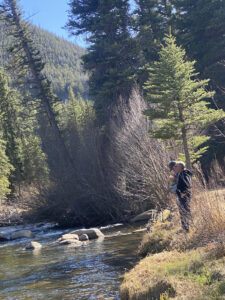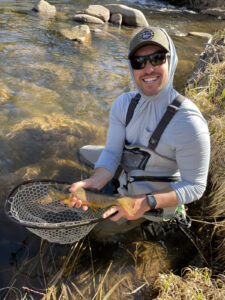Fishing season is back! The waders, boots, and rods are out and ready to go. It is shaping up to be another water year that favors the angler. Depending on spring precipitation, there is a chance we see our peak runoff a couple weeks early. Similar to last summer, this tends to jumpstart our hatches earlier than usual. Don’t miss out on early summer fishing! Before heading out to fish, be sure to check out Ben Riedel’s Taylor River Fishing Report – May 2022 for the latest tips.
Taylor River Fishing Report – May 2022
Fishing on the Taylor River is getting better every day. This winter had moments of glory, but a warm, windy, and dry spring has the forecast looking similar to last summer. Although more water is needed, lower water does benefit the angler in the spring. The Taylor River at Wilder is slightly off color, flowing around 400 cfs, 200 cfs of that is coming out of the dam.
Trout are starting to spread out into shallower water during the warmer, buggier times of day. Otherwise, expect to find them in their deeper winter holding lies. Waiting for the water to warm up is beneficial. The fish are sluggish and their metabolism is slow in the morning.
 Nymphing in the slower, deeper pools is about the only worthwhile way to approach these fish. A variety of flies will suffice due to the abundance of natural food still in the water. Pat’s Rubber Legs, BH 20 incher, Worms, Pheasant Tails, Micro Mayflies, and Zebra Midges have been productive. The key is getting a natural drift where the fish are. Keep in mind the bottom of the river seldomly flows as fast as the surface, and fish are indeed on or near the bottom.
Nymphing in the slower, deeper pools is about the only worthwhile way to approach these fish. A variety of flies will suffice due to the abundance of natural food still in the water. Pat’s Rubber Legs, BH 20 incher, Worms, Pheasant Tails, Micro Mayflies, and Zebra Midges have been productive. The key is getting a natural drift where the fish are. Keep in mind the bottom of the river seldomly flows as fast as the surface, and fish are indeed on or near the bottom.
As the water warms up, trout can and will start to eat more. Look for small bugs emerging. That is easier said than done. Observe the birds in the area. If you see them out swooping the river, or eating overhead, suspect small insects emerging that you hadn’t noticed because of their sheer size. There have been prolific midge hatches already this spring, enough to bring the occasional fish to the surface. Zebra Midges, Black Beauties, and WD-40s in sizes 20 and 22 often find the corner of the mouth. A WD-40, Barr’s BWO Emerger, or a Pheasant tail will cover you in the event you see small mayflies. There have been a few days of sparse, sporadic, but rewarding Blue Wing Olive hatches. These are always the first bug besides midges to hatch for the year. Followed by multiple stoneflies, Green Drakes, and Caddis. I suspect we will see these bugs earlier than usual, similar to last summer.
 The ponds at Wilder are the most consistent fishing on the property. The only hatches so far have been tiny midges, but abundant enough in number to keep the fish on steady feeding patterns. Try to identify which direction the fish is cruising, lead the fish by 6 ft. or more with a size 18-22 Griffiths Gnat, Sierra Dot or Black Beauty. If there isn’t a midge hatch, consider throwing a small size 12 Olive Woolly Bugger, or even a small nymph. Let it sink to the bottom, and use short slow strips to imitate Damselfly nymphs. You wouldn’t believe how many Damselfly nymphs are in the vegetation.
The ponds at Wilder are the most consistent fishing on the property. The only hatches so far have been tiny midges, but abundant enough in number to keep the fish on steady feeding patterns. Try to identify which direction the fish is cruising, lead the fish by 6 ft. or more with a size 18-22 Griffiths Gnat, Sierra Dot or Black Beauty. If there isn’t a midge hatch, consider throwing a small size 12 Olive Woolly Bugger, or even a small nymph. Let it sink to the bottom, and use short slow strips to imitate Damselfly nymphs. You wouldn’t believe how many Damselfly nymphs are in the vegetation.
Stay safe and pinch your barbs,
Ben Riedel
Master Fly-Fishing Guide
Wilder on the Taylor









